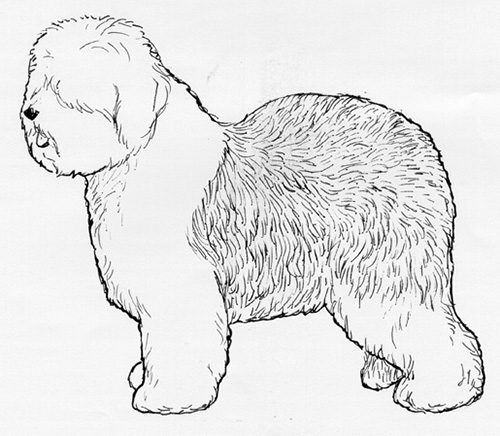Old English Sheepdog
Herding Dog Group
The goals and purposes of this breed standard include: to furnish guidelines for breeders who wish to maintain the quality of their breed and to improve it; to advance this breed to a state of similarity throughout the world; and to act as a guide for judges.
Breeders and judges have the responsibility to avoid any conditions or exaggerations that are detrimental to the health, welfare, essence and soundness of this breed, and must take the responsibility to see that these are not perpetuated.
Any departure from the following should be considered a fault, and the seriousness with which the fault should be regarded should be in exact proportion to its degree and its effect upon the health and welfare of the dog and on the dog’s ability to perform its traditional work.
History
The Old English Sheepdog is a relatively young breed, being not much more than 200 years old. Its use as a herding and droving dog and its physical appearance suggests relation to the Bearded Collie and the Polish Owczarek Nizinny. The required bobbed tail of the breed has its roots in the British tradition of docking the tails of working dogs for identification, as there was a tax exemption for all dogs that worked for a living.
The Old English Sheepdog was recognized by the United Kennel Club in 1948.
General Appearance
The Old English Sheepdog is a strong, muscular, compact, thick-set, square, balanced, able-bodied dog with profuse, but not excessive coat. He stands lower at the withers than at the loin, and has a pear-shaped body when viewed from above. He is absolutely free from legginess, and his gait has a typical roll at the amble and the walk.
Characteristics
The Old English is an adaptable, intelligent breed, with an even disposition; never showing signs of aggressiveness, shyness or nervousness.
Head
SKULL
Broad and capacious, rather square. The supraorbital ridges over the eyes are well-arched. The stop is well defined.
MUZZLE
Fairly long and strong, square and truncated.
Very Serious Faults (to the point of being considered deformities): Long, narrow head. Snipey muzzle.
TEETH
A full complement of strong, large, evenly placed, white teeth meet in a scissors bite. An even bite is acceptable but not desirable.
EYES
Dark or wall eyes, set well apart. Two blue eyes are acceptable. Complete pigmentation on the eye rims is preferred.
Serious Faults: Light amber or yellow eyes.
EARS
The medium-size ears are carried flat to the side of the head.
NOSE
Large and black, with wide opened nostrils.
Neck
The fairly long neck is gracefully arched.
Forequarters
Shoulder blades are well laid back, and the shoulders are narrower at the withers than at the point of shoulder.
FORELEGS
The straight forelegs have plenty of bone. The distances measured from the withers to the elbow and from the elbow to the ground are approximately the same. The elbows are held close to the brisket.
Body
The rather short, very compact body is broader at the rump than at the shoulders. The withers are lower than the loin; this is a breed characteristic. The gently arched loin is very stout. The ribs are well sprung; never being slab sided. The brisket is deep and capacious.
Hindquarters
The hindquarters are round and muscular.
HIND LEGS
The stifles are well-turned, and the second thigh is long and well-developed. Rear pasterns are short and perpendicular.
Feet
Small, round and tight, with thick pads and well-arched toes. Dewclaws should be removed.
Tail
Natural bob, docked completely, or natural. If natural, the tail is low-set and never curled or carried over the back. It should be well-feathered with hard textured coat.
Coat
Profuse and of hard texture, the outer coat is not absolutely straight, but is shaggy and free from curl. The undercoat is a waterproof pile. The head is well-covered with hair. The ears are moderately coated. Neck and forelegs are well coated. The hindquarters are more heavily coated than the rest of the dog. Quality, texture and thickness of coat are to be given more consideration than length.
The natural outline of the dog and the coat's natural texture are never to be changed by an artificial means. The feet and rear may be trimmed as necessary for cleanliness.
Faults: Soft coat. Flat coat.
Color
Any shade of grey, grizzle or blue. The body and hindquarters are solid color, with or without white stockings. The head, neck, forequarters and underbelly are white, with or without markings.
Fault: Any shade of brown.
Disqualification: Albinism.
Height
Height at the withers for males is 24 inches and upwards; for females, 22 inches and upwards. However, type and symmetry are of the greatest importance and are not to be sacrificed for size alone.
Gait
When walking, the Old English Sheepdogs exhibits a characteristic bear-like roll from the rear. At the trot, he shows effortless extension and strong drive. At slow speeds, some dogs may tend to pace. When moving, the head carriage may be in a naturally lower position.
Disqualifications
(A dog with a Disqualification must not be considered for placement in a conformation event, and must be reported to UKC.)
Unilateral or bilateral cryptorchid.
Viciousness or extreme shyness.
Albinism.

Looking for a Dog?
Find a dog that will fit your family.
Note: The breeders on this list are not endorsed by UKC.
Revised January 1, 2008
©Copyright 1992, United Kennel Club
